Mathematical Sandbox: How Quantitative Systems Pharmacology Steers Safer, Faster Drug Development

Fear and anxiety swirled when Dr. Cynthia J. Musante’s husband contracted COVID-19. He faced agreater risk of coming down with a severe casesince he was already unwell.
But all their worries vanished in just 24 hours.
Dr. Musante recalls that her husband soon started to feel better after being prescribed an investigational oral treatment for those with COVID-19. “It felt like a miracle,” he said. “I had felt so horrible.”
As relief settled in, Dr. Musante felt something else: pride.
After all, from the time the oral medication became available in late 2021 to its approval in late May 2023, clinicians dispensed more than 11 million prescriptions for the treatment.1 If not for Dr. Musante's 11-person quantitative systems pharmacology team and many other colleagues at Pfizer, millions of people with COVID-19, including her husband, might have waited months to access the oral treatment.
Predicting Patient Outcomes From the Outset
Quantitative systems pharmacology is a high-tech branch of biomedical research that aids drug development from discovery through clinical trials and beyond. In this field, scientists build mathematical models to simulate interactions among medications and their targets.
At Pfizer, the team creates fit-for-purpose models to generate and test hypotheses before treatments reach patients. This way, they work to predict outcomes from a cellular level up to whole-body response, and they run virtual clinical trials.
“We’re an in-silico (computer-based) pharmacology group that’s trying to predict what happens to our potential treatments when we put them into a patient for the first time,” Dr. Musante, Pfizer’s Vice President of Scientific Research and Head of Quantitative Systems Pharmacology, says. “It’s always about ensuring safety first and then trying to understand how to maximize the therapeutic effect of our medicines.”
Quantitative systems pharmacology gets medicine to patients quicker, improves how well they work, and minimizes patient risk—especially for new treatments. Pfizer’s team has done this by forecasting the effects of new treatment combinations, identifying how much and how often someone should take a medication to get the best results, and helping to select biomarkers to measure how a treatment performs. The group also informs whether Pfizer continues to investigate a certain treatment.
The team's work touches the lives of those they know and love—along with millions of patients around the world. Yet few people know quantitative systems pharmacology exists at all.
Turning Mathematics into Medicine
So many people have asked Dr. Musante to explain quantitative systems pharmacology—using math to describe biology and predict responses to medicines, more or less—that she has an easy-to-grasp metaphor on hand.
Imagine eating a sandwich.
Scientists know how to measure how many calories the sandwich contains, in the form of carbohydrates, proteins, and fats. By observing how long it takes you to eat the sandwich, they can calculate the average rate at which the sandwich enters your stomach. For example, if the sandwich is 400 calories and you eat it in 20 minutes, the average caloric input rate is 400 calories divided by 20 minutes, or 20 calories/minute. From there, the sandwich is broken down into its individual nutrients which empty into the intestinal tract, eventually are absorbed into the bloodstream, and are delivered to different organs for utilization, storage, or excretion.
If scientists wanted to predict how quickly your body might process a sandwich, they need only to express each small step as a mathematical formula and then combine them into one comprehensive description, or system of equations
Replace the sandwich with a medicine, and you’re on your way to understanding quantitative systems pharmacology.
“One thing that’s always excited me is trying to understand what’s going on in the human body,” Dr. Musante says. “Mathematics can describe what is going on around us and within us.”
But medicines are more complicated than sandwiches. Building a mathematical model in the real world often means filling in the gaps left by data they don’t have and answering lingering questions about the information they do have.
In the case of the investigational oral treatment for COVID-19, the team began problem-solving before they knew the exact questions they’d need to answer—or whether Pfizer would officially put them on the project at all.
The Mathematical Sandbox
In March 2020, the COVID-19 pandemic was threatening lives around the world, and the operations of many clinical trials and biology labs came to a halt during lockdown. Amid text messages about colleague well-being and the more practical matters of navigating home childcare and grocery shopping, the team started to prepare a model. They wanted to be ready just in case they could help, says Principal Quantitative Systems Pharmacologist Dr. Rohit Rao, who at that time had only been at Pfizer a few months.
Soon enough, the clinical team knocked on their door with a question: Would patients respond to the trial medicine within five days? Or did it need twice that long to work?
The answer carried profound implications. Compared to a five-day regime, testing a 10-day treatment would demand more patients and a longer trial at a time when the virus was infecting thousands of people a month, Dr. Rao explains. To get those answers, they needed a virtual clinical trial.
This is where quantitative systems pharmacology shines. The group offers a mathematical sandbox where programs can test what-if scenarios, Associate Research Fellow Dr. Blerta Shtylla explains, pointing to an oncology program she's particularly passionate about.
For almost three years, they’ve supported the development of a therapy for relapsed and refractory multiple myeloma. Their model can simulate treatment periods that are longer than existing clinical observations. This enables experts to predict with confidence and test dose and regimen scenarios.
Dr. Shtylla has worked on the program closely, and the results aren’t just important for her professionally. They’re personal, especially since her PhD mentor has multiple myeloma.
“We know who the patients are,” she says.
Seeing medicines transform patients’ lives is what gives their work real meaning. Dr. Musante remembers tearing up as she read early data from an oncology program that showed patients responding to the treatment. And after losing two sisters to cancer at a relatively young age, she knows what's at stake.
"We realized we were really changing these patients' lives," she says. "To see the response, I thought it was so wonderful for patients and their familiies."
Dr. Cynthia J. Musante and her husband, Neil.
Working in Harmony
Everyone in quantitative systems pharmacology is quick to say success comes from collaboration. When it came time to advance the investigational oral treatment for people with COVID-19, the quantitative systems pharmacology team worked with preclinical biologists and other experts to help get the medication to people who needed it.
“It truly takes a village,” Dr. Rao says.
The breadth of problems they encounter calls for equally diverse expertise. The team includes mathematicians, engineers, pharmaceutical scientists, and biostatisticians. And they also regularly partner with expert colleagues throughout Pfizer, taking a somewhat hybrid approach. That includes collaboration with artificial intelligence and precision medicine experts.
Dr. Musante particularly enjoys crafting models for the precision medicine team and exploring how genetic mutations impact biological pathways and a patient's response to treatment. She’s also excited about ongoing work with Pfizer's artificial intelligence team to explore AI and machine learning, combining the technologies’ aptitude for crunching data with her team’s knowledge of pharmacology and disease biology.
Dr. Shtylla calls this hybrid approach “QSP 2.0” and says it already helps the team identify key dimensions of data to integrate into models. One day, the strategy may accelerate how quickly they assemble models.
Life-changing Results
Thoughts of friends, family, and people everywhere were on the team members’ minds as they ran virtual clinical trials for the COVID-19 oral treatment.
“We had one shot to get this right,” Dr. Rao says.
The simulation results came in: Five days of treatment would work. Clinical teams now had increased confidence to launch the shorter clinical trial. And with that, the quantitative systems pharmacology team helped to cut the time it took for the oral treatment to reach patients.
“This really has the impact of saving a lot of lives,” Dr. Rao says.
A few days after taking the oral treatment for COVID-19, Dr. Musante’s husband fully recovered. She ended up taking it, too. Only a few years later, the same model that helped them—and so many others—has driven a study on the effects of longer dosing in immunocompromised patients.
Expect more life-changing results ahead.
"For us, a successful model is never the end," Dr. Musante says. "It's always a new beginning for the patients who need these treatments."
References:
1. COVID pill Paxlovid gets full FDA approval after more than a year of emergency use. ABC News. https://abcnews.go.com/Health/wireStory/covid-pill-paxlovid-gets-full-fda-approval-after-996073791. Published May 25, 2023. Accessed June 5, 2023.
![]()






